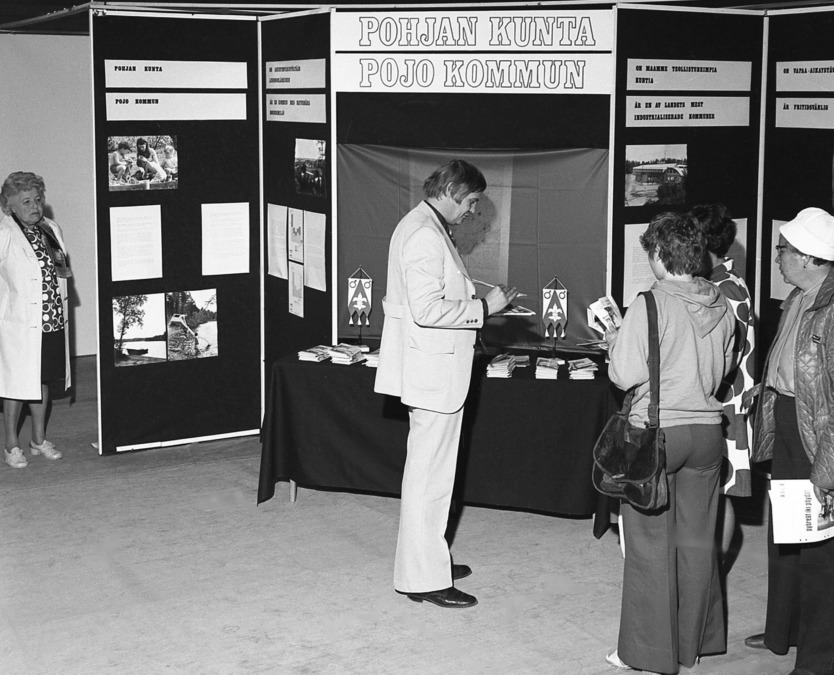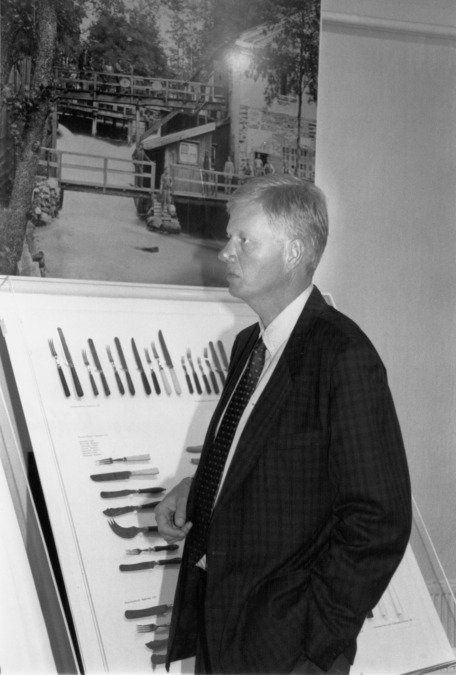In 1969 Karl-Erik Lindqvist, also known as “Pojo-Kalle”, became the municipality director of Pohja. Industrial manufacturing still played a big role in the municipality, but the winds of change had begun to blow. Fiskars ironworks was the center of the Pohja municipality, with its own hospital, pharmacy, municipality doctor, and several shops. In order to further develop the services of the Pohja municipality, Kalle Lindqvist sought to build the city centre in Pohja. In the 1970s and 1980s a municipal hall, a library and a healthcare centre was built next to the church in Pohja.
When both employment and inhabitants in Fiskars started to decline, the maintenance of its buildings became a concern. Should they be preserved, and how would their future be ensured? The answer was found in a property company called Pohjan Ruukkiteollisuus, owned by the Pohja municipality. In 1984 the property company bought several buildings in Fiskars and Billnäs from the Fiskars corporation. The goal was to preserve the cultural environment of the ironworks, and to attract new residents and businesses to the old buildings. For hundreds of years heavy industry had been a part of the municipality, but times were changing. The Fiskars corporation later repurchased the Cutlery Mill, where knives were made up until 1984. After the sale the building became known as the Copper Smithy.

Ingmar “Inko” Lindberg has been attributed with the successful transformation of the Fiskars ironworks, as he managed to transform the ironworks from a former industrial manufacturer to a home for different artists and craftsmen. Pojo-Kalle and the municipality however are credited with getting this process started in the first place. The municipality had big plans to attract artists and craftsmen to the ironworks. It also organized the Expohja art exhibition in the Copper Smithy. The times and economic trends however were not ideal for the municipality, and the Fiskars corporation eventually had to finish the project.
Expohja and later exhibitions
The first art exhibition in Fiskars was held in the Copper Smithy in 1985. The exhibition, called Expohja, was carried out by Matti Honkala. The final Expohja exhibition took place in 1989, when this activity came to an end due to financial challenges. Soon after this the Fiskars corporation repurchased the Copper Smithy, and in 1994 exhibitions continued there due to the initiative of local artists and craftsmen. This marked the beginning of a co-operative, later to be called Onoma. The name Onoma comes from the Finnish words on (is) and oma (own).
Pohjan ruukkiasunnot
The Pohja municipality founded the property company Pohjan Ruukkiteollisuus in the early 1980s. Its aim was to salvage the culturally and historically important buildings in the Fiskars and Billnäs ironworks. The Fiskars corporation owned empty and abandoned industrial facilities in Fiskars and Billnäs that it no longer had use for. These were sold to Pohjan ruukkiasunnot, and the sale also included residential apartments. Soon after, Pohjan ruukkiasunnot began renovating the properties. Residents temporarily moved elsewhere, and many apartments were fitted with saunas. During this time, the communal sauna and washroom was closed down. This caused much protest among the residents. Many apartments lacked modern conveniences, making the communal sauna and washroom a necessity. Rents soared after the renovations, making it difficult for residents to afford moving back in.
The plan to build a modern row house with a shed roof in Hasselbacka caused the biggest protests among residents. One of the traditional red wooden houses in Hasselbacken had burned down just as the renovations were completed. In its stead, Pohjan ruukkiasunnot wanted to build something more modern. This caused concern and protests, and eventually these plans were cancelled.
Part of the sale was the building known today as the Copper Smithy. The north end of the building housed the art exhibition Expohja between 1985 and 1989. Soon after, the Fiskars corporation repurchased the building. Today it houses a restaurant and spaces for formal occasions and exhibitions. In 2008, businessman Olli Muurainen became the owner of Pohjan ruukkiasunnot. In the 2010s and 2020s he renovated several old factories in Billnäs ironworks, turning them into hotels and conference spaces. Muurainen also owns several buildings in Fiskars ironworks. Thus, the memory of the Pohja municipality owning two prominent ironworks still echoes today.
Ingmar ”Inko” Lindberg
Ingmar Lindberg became the development director of the Fiskars Corporation in 1985, working from the Helsinki office. He was charged with areas such as communication and in-service training. He soon became property manager in Fiskars, as former manager Olof Bruncrona moved to other tasks. The Fiskars ironworks was in a poor state, both physically and spiritually. The buildings were dilapidated, and there was an abundance of staff. The ironworks was operating at a loss, and it was Lindberg’s job to make the ironworks profitable again. After much pondering, an idea came to him one night; to attract creative people and artists to the village. Some had already found their way to Fiskars, but most artists and craftsmen came to Fiskars on Lindberg’s initiative.

Fiskars repurchased the Copper Smithy, where the art exhibitions in Fiskars had started taking place. The building had housed the municipality supported Expohja-exhibition, and other art exhibitions by the Fiskars-newcomers. In 1996 the co-operative called Onoma was founded, and Lindberg became the chairman of the co-operative. Inko Lindberg played a significant role in the development of the Fiskars ironworks. He understood that its buildings needed people to live in them and to use them for different purposes. Life had returned to the Fiskars ironworks, and hence the future of its buildings and their preservation was secured.
